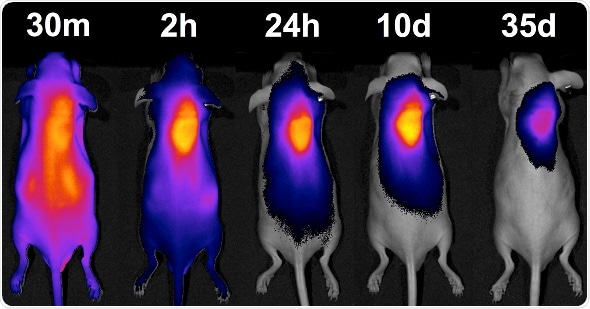Jun 17 2019
Killing tumor cells while sparing their normal counterparts is a central challenge of cancer chemotherapy. If scientists could put a “homing beacon” in tumors, they could attract these medicines and reduce side effects caused by the drugs acting on healthy cells. Now, researchers have made a hydrogel that, when injected near tumors in mice, recruits drugs to shrink the tumor with fewer side effects. They report their results in ACS Central Science.

In mice, a hydrogel recruits a dye-labeled molecule (colored areas) to its location, showing its potential for being a “homing beacon” for cancer drugs. Credit: Adapted from ACS Central Science 2019, DOI: 10.1021/acscentsci.9b00195
Scientists have tried to target chemotherapy drugs to tumors by attaching antibodies that bind to proteins expressed on the cancer cells’ surfaces. However, less than 1% of the administered drug actually ends up at the tumor site. Matthew Webber and colleagues decided to take a different approach: using cucurbituril to target therapies to a tumor. Cucurbituril is a pumpkin-shaped molecule that can capture certain other chemicals within its central cavity. If the researchers could inject cucurbituril near a tumor, and then attach targeting chemicals to chemotherapy drugs, they might be able to retain the drugs at the tumor site through these interactions. Then, the abnormally acidic microenvironment of the tumor would rupture the linkage between the drug and the targeting chemical, unleashing the therapy to kill cancer cells.
To test their approach, the researchers first injected a hydrogel containing cucurbituril under mice’s skin. They attached a dye to the targeting molecule so they could easily track it, and then injected that into the mice’s bloodstream. They found that 4.2% of the injected dye ended up in the hydrogel, which is much higher than previously reported antibody approaches. The mice quickly excreted the majority of the dye that was not bound to the hydrogel. When the team injected the hydrogel adjacent to tumor xenografts in mice and then administered the cancer drug doxorubicin attached to the targeting molecule, the mice’s tumors showed much slower growth, and the mice had fewer side effects than those given unmodified doxorubicin. The hydrogel persisted in the mice’s body for more than 45 days, which could allow repeated doses of chemotherapy drugs, or the use of different drugs with the same targeting molecule, the researchers say.
Source:
American Chemical Society
Journal reference:
Webber, M.J. et al. (2019) Spatially Defined Drug Targeting by in Situ Host–Guest Chemistry in a Living Animal. ACS Central Science. doi.org/10.1021/acscentsci.9b00195.